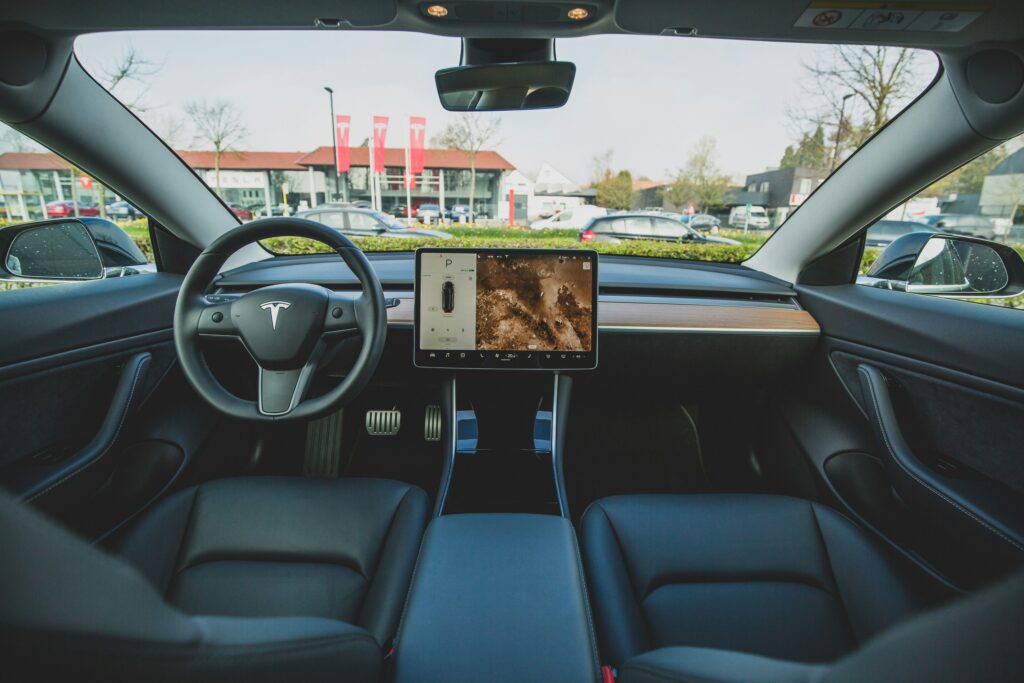Founded in 2003 and headquartered in Austin, Texas, Tesla Inc. (NASDAQ:TSLA) has grown from a niche electric vehicle startup into one of the world’s most valuable and disruptive technology companies. With a mission to accelerate the world’s transition to sustainable energy, Tesla has consistently pushed the boundaries of innovation in electric mobility, renewable energy solutions, and more recently, artificial intelligence and robotics. Co-founded by Martin Eberhard and Marc Tarpenning, and propelled into global prominence by CEO Elon Musk, Tesla initially captured attention with its high-performance electric sports car, the Tesla Roadster. However, it was the launch of the Model S sedan in 2012 that truly established Tesla as a pioneer in the electric vehicle (EV) revolution.
Since then, Tesla has expanded its lineup to include the mass-market Model 3, the Model X SUV, the Model Y crossover, and is preparing for the full-scale rollout of its futuristic Cybertruck and next-generation autonomous vehicles. The company’s vertically integrated business model, which includes in-house battery development, proprietary vehicle software, AI-powered Full Self-Driving (FSD) systems, and global manufacturing facilities such as Gigafactories in Nevada, Shanghai, Berlin, and Texas, has allowed it to scale with efficiency and maintain technological leadership across multiple industries.
Beyond automobiles, Tesla has emerged as a major player in the renewable energy and power storage sectors through its Solar Roof, Powerwall, and Megapack systems. These offerings are integral to Tesla’s larger vision of a decentralized, sustainable energy ecosystem that reduces global reliance on fossil fuels. The company’s energy division continues to grow rapidly, with demand for battery storage and utility-scale energy solutions reaching all-time highs.
In recent years, Tesla has aggressively pursued innovation in artificial intelligence, particularly with its Dojo supercomputer—an AI training platform purpose-built to accelerate autonomous driving capabilities. Complementing this is Tesla’s ambitious entrance into the robotics space with Optimus, a humanoid robot project aimed at transforming industrial labor and everyday human tasks. This strategic pivot toward robotics and AI infrastructure suggests that Tesla is positioning itself not just as a carmaker, but as a future-facing technology conglomerate.
Today, Tesla’s influence extends far beyond the auto industry. It is one of the most followed stocks in the world, listed on the NASDAQ under the ticker symbol TSLA, with a market capitalization that often rivals the combined value of several traditional automakers. Despite facing scrutiny over valuation, regulatory challenges, and executive leadership, Tesla continues to be a symbol of innovation, disruption, and bold vision—attracting both passionate supporters and vocal critics.
Whether through cutting-edge electric vehicles, sustainable energy solutions, or AI-driven autonomy, Tesla remains at the forefront of shaping what many believe will be the defining industries of the 21st century.
Robotaxis and Autonomous AI Fleets: Tesla’s Path to Recurring Revenue Dominance
One of the most exciting near-term catalysts for Tesla bulls is the company’s move into autonomous transportation. Elon Musk has long predicted that robotaxis would transform Tesla from a high-margin car business to a software-as-a-service (SaaS) platform. That vision is beginning to materialize. In June 2025, Tesla launched a limited robotaxi service in Austin, Texas, using a fleet of camera-only Model Y vehicles supported by remote operators. While critics note the absence of LIDAR as a potential safety drawback, Tesla insists its pure-vision AI approach is not only scalable but also superior in long-term efficiency.
This development positions Tesla as a real competitor to Waymo, Cruise, and other players in the self-driving space. But unlike its competitors, Tesla has millions of cars already on the road, gathering real-world driving data through its Full Self-Driving (FSD) beta software. This trove of data, combined with Tesla’s proprietary Dojo supercomputer, offers a significant edge in training AI models for real-world autonomy. By 2026, Tesla aims to commercialize its custom-built Cybercab—an autonomous electric vehicle purpose-built for ride-hailing—potentially disrupting the global $1 trillion transportation-as-a-service (TaaS) market.

CHECK THIS OUT: MicroVision (MVIS): A Top Pick in Autonomous Tech Stocks and Innoviz (INVZ) May Be Severely Undervalued — Investors Shouldn’t Ignore This Stock.
Beyond Cars: Tesla’s Energy Business Is Quietly Booming
While headlines focus on Tesla’s robotaxi ambitions and CEO Elon Musk’s social media presence, the company’s energy segment is quietly becoming a powerhouse in its own right. In Q1 2025, Tesla’s energy storage revenue jumped 67% year-over-year, thanks to skyrocketing demand for its Megapack utility-scale battery systems. This division alone brought in over $10 billion in annualized revenue, driven by global decarbonization trends and grid modernization projects.
As governments implement new clean energy mandates and invest in battery storage to stabilize intermittent renewables, Tesla’s energy business is poised to benefit. With competitors like CATL and Fluence still struggling with cost parity and scalability, Tesla’s vertically integrated approach offers a long-term moat. Even potential tariffs and export restrictions, while a short-term headwind, may accelerate onshoring of Tesla’s energy products in the United States—aligning the company with national industrial policy goals and green incentives.
Dojo, Optimus, and the Bold Leap into AI Robotics
Tesla’s AI narrative goes far beyond self-driving cars. The company is aggressively pursuing breakthroughs in robotics and AI hardware, centered around its in-house supercomputer, Dojo. Designed to process vast quantities of driving video and simulate edge cases in autonomy, Dojo could become the cornerstone of Tesla’s future as an AI infrastructure company.
Even more ambitious is the Optimus humanoid robot project. According to Elon Musk, Tesla aims to produce thousands of these robots by the end of 2025, with the goal of scaling to millions annually by the end of the decade. While critics remain skeptical—arguing that humanoid robotics is still a science fiction dream—the implications are staggering. If even modest levels of general-purpose labor automation are achieved, Optimus could unlock entirely new business models in manufacturing, logistics, and eldercare.
Addressing the Bear Case: Operational Challenges and Valuation Risks
To be clear, the bears haven’t been silent. In June 2025, a bearish thesis published by Stefan Waldhauser on High Growth Investing’s Substack warned of deteriorating fundamentals and a reliance on speculative growth narratives. Tesla’s Q1 earnings revealed a 20% year-over-year decline in vehicle revenue and a two-thirds drop in operating income. The core auto business, which once drove Tesla’s meteoric rise, actually turned red during the quarter. Forward guidance was conspicuously absent, citing disruptions from a Model Y production shift.
Short sellers also highlight Tesla’s sky-high valuation, with a forward P/E of 166.67 and trailing P/E of 184.09. Bears argue that Tesla’s traditional auto business supports only a fraction—perhaps 10%—of its $800 billion market capitalization. Others raise alarms about export restrictions, executive turnover, and the company’s over-reliance on Elon Musk’s volatile leadership.
Despite all of this, the stock continues to rise. Why? Because even as the auto segment faces cyclical pressure, Tesla is being priced as a leader in multiple next-gen markets—robotaxis, energy storage, humanoid robotics, and AI chips. For every bear pointing to a Model Y miss, there is a bull forecasting robotaxi revenues exceeding $100 billion annually. For every critic questioning FSD safety, there is an investor betting on Dojo becoming the “AWS of AI infrastructure.”
Hedge Fund Activity and Market Sentiment
Interestingly, hedge fund sentiment toward Tesla has softened slightly. According to public data, 104 hedge fund portfolios held TSLA as of Q1 2025, down from 126 in the previous quarter. While this dip suggests cautious positioning, it doesn’t necessarily indicate bearish consensus. Many funds are likely reallocating capital toward shorter-term AI plays or diversifying exposure to mitigate Tesla’s volatility. Still, TSLA remains one of the most-watched and most-traded large-cap stocks on the market.
Tesla’s loyal retail investor base remains strong, and with analysts like Wedbush setting long-term price targets north of $400, institutional support remains intact. Technical indicators also point toward bullish momentum, with the recent golden cross formation adding further confidence to short- and medium-term price trajectories.
Conclusion: Why the Long-Term Bull Case Still Holds
Tesla is not without flaws. It is currently facing operational turbulence, valuation scrutiny, and regulatory uncertainties. But investors who believe in the future of AI, robotics, and clean energy must also acknowledge that Tesla is one of the few companies at the intersection of all three. From robotaxis and Dojo to Megapack energy solutions and Optimus humanoid labor, Tesla isn’t just surviving—it’s reinventing its identity.
While the bear case emphasizes current weakness in auto margins and executive overreach, the bull case envisions a future where Tesla redefines transportation, energy, and even human labor itself. Betting on Tesla today is not simply a wager on electric cars. It’s a long-term conviction in a multi-sector platform that could lead the next industrial revolution.
READ ALSO: Golden Matrix Group (GMGI): The Explosive iGaming Stock You’re Probably Sleeping On and This AI Stock Powers Millions of Conversations Daily—LivePerson (LPSN) Deserves a Spot on Your Watchlist.






